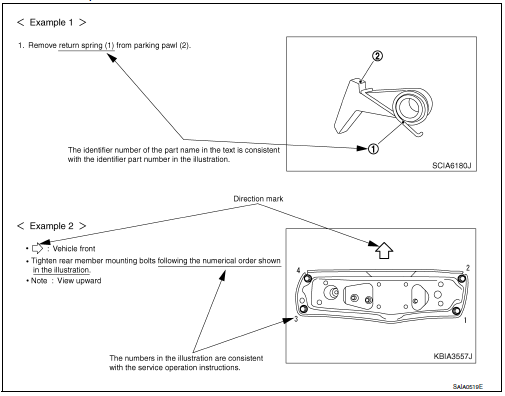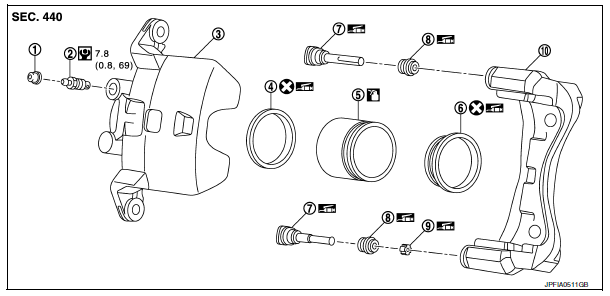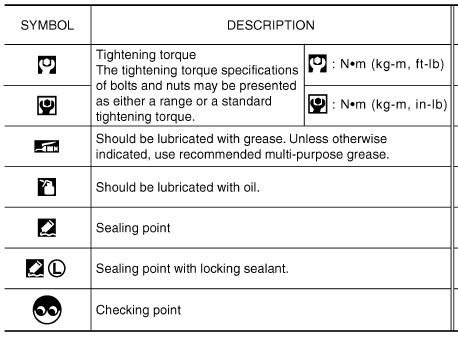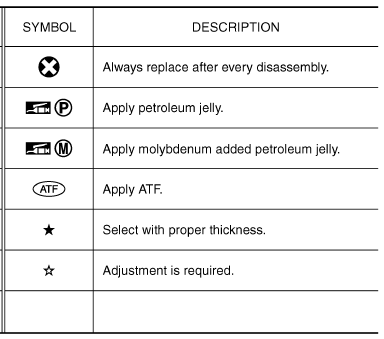Nissan Sentra Service Manual: How to use this manual
Description
This volume explains “Removal, Disassembly, Installation, Inspection and Adjustment” and “Trouble Diagnoses”.
Terms
- The captions WARNING and CAUTION warn you of steps that must be followed
to prevent personal injury
and/or damage to some part of the vehicle.
WARNING indicates the possibility of personal injury if instructions are not followed.
CAUTION indicates the possibility of component damage if instructions are not followed.
BOLD TYPED STATEMENTS except WARNING and CAUTION give you helpful information.
Standard value: Tolerance at inspection and adjustment.
Limit value: The maximum or minimum limit value that should not be exceeded at inspection and adjustment.
Units
- The UNITS given in this manual are primarily expressed as the SI UNIT
(International System of Unit), and
alternatively expressed in the metric system and in the yard/pound system.
Also with regard to tightening torque of bolts and nuts, there are descriptions both about range and about the standard tightening torque.
“Example”
Range
Outer Socket Lock Nut : 59 - 78 NВ·m (6.0 - 8.0 kg-m, 43 - 58 ft-lb)
Standard
Drive Shaft Installation Bolt : 44.3 NВ·m (4.5 kg-m, 33 ft-lb)
Contents
- A QUICK REFERENCE INDEX, a black tab (e.g.
 ) is provided on the first page.
) is provided on the first page.
You can quickly find the first page of each section by matching it to the section's black tab. - THE CONTENTS are listed on the first page of each section.
- THE TITLE is indicated on the upper portion of each page and shows the part or system.
- THE PAGE NUMBER of each section consists of two or three letters which designate the particular section and a number (e.g. “BR-5”).
- THE SMALL ILLUSTRATIONS show the important steps such as inspection, use
of special tools, knacks of
work and hidden or tricky steps which are not shown in the previous large
illustrations.
Assembly, inspection and adjustment procedures for the complicated units such as the automatic transaxle or transmission, etc. are presented in a step-by-step format where necessary.
Relation between Illustrations and Descriptions
The following sample explains the relationship between the part description in an illustration, the part name in the text and the service procedures.

Components
- THE LARGE ILLUSTRATIONS are exploded views (see the following) and
contain tightening torques, lubrication
points, section number of the PARTS CATALOG (e.g. SEC. 440) and other
information necessary to
perform repairs.
The illustrations should be used in reference to service matters only. When ordering parts, refer to the appropriate PARTS CATALOG.
Always check with the PARTS DEPARTMENT for the latest parts information.
Components shown in an illustration may be identified by a circled number. When this style of illustration is used, the text description of the components will follow the illustration.

- Cap
- Bleeder valve
- Cylinder body
- Piston seal
- Piston
- Piston boot
- Sliding pin
- Sliding pin boot
- Bushing
- Torque member
 Apply rubber grease.
Apply rubber grease.
 Apply brake fluid.
Apply brake fluid.
 NВ·m (kg-m, in-lb)
NВ·m (kg-m, in-lb)
 Always replace after every
Always replace after every
disassembly
Symbols


- How to follow trouble diagnoses
- How to read wiring diagrams
- Abbreviations
- Tightening torque of standard bolts
- Recommended chemical products and sealants
Other materials:
Evap leak check
Inspection
CAUTION:
Do not use compressed air or a high pressure pump.
Do not exceed 4.12 kPa (0.042 kg/cm2, 0.6 psi) of pressure in EVAP
system.
NOTE:
Do not start engine.
Improper installation of EVAP service port adapter [commercial
service tool: (J-41413-OBD)] to the EVAP
...
Making a call
To make a call from a phone connected to the
vehicle’s Bluetooth® Hands-Free Phone System:
NOTE:
Available commands different if system is
in Manual Control mode. See “Manual Control”
in this section for more information.
Press the button.
The system will prompt you for a command. ...
P0453 EVAP Control system pressure sensor
DTC Logic
DTC DETECTION LOGIC
DTC No.
CONSULT screen terms
(Trouble diagnosis content)
DTC detecting condition
Possible cause
P0453
EVAP SYS PRES SEN
(Evaporative emission system
pressure sensor/switch high)
An excessively high voltage from the
sensor is ...


